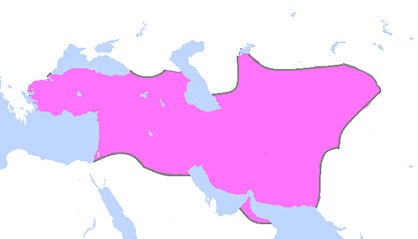Chapter Two: Faith and Religious Identity
Religious Pluralism
Islamic states also tolerated religious laws of non-Muslim communities, considered a “people of the book” or ahl al-kitab. The concept of tolerated religious communities is called Dhimma in Islamic law, and the communities are therefore called Dhimmi. Under Islamic law, states had to recognize these religious communities because they are sanctioned by the Qur’an. Because their prophets and scriptures are recognized in Islamic law, ahl al-Kitab were allowed to continue their religious and communal functions within the larger social and legal contexts. At the same time they had different rights and obligations than their Muslim counterparts. For example, the jizya was a tax for Dhimmi. Dhimmi were also exempt from military service, however, and did not pay the alms that Muslims were expected to pay, somewhat leveling the balance of obligation between Muslims and non-Muslims.
The Ottoman Empire is example of an example of an Islamic state which governed according to the precept of Dhimma. Dhimmi were called millet. The word millet means religion or religious community, but it can also be translated as nation due to affinity between ethnicity and religious identity at the time. The millet operated under the rules of the Dhimma mentioned in the previous paragraphs, and maintained thriving communities in all the major cities of the empire. The Ottoman Empire is often recognized for its achievement of pluralistic governance because of this, although the minorities also faced some level of discrimination. Armenian Christians are one such community, which was displaced after the Turkish war of independence and the end of the Ottoman Empire.
On the other hand, a great example of religious tolerance also comes from the Middle East. The Biblical story and centers on the figure of Cyrus the Great, the King of the Persian Empire. The Bible says of Persian Achaemenian King, Cyrus, The Great:
‘So said the Lord to His anointed one, to Cyrus’
—Isaiah, Isa 45:1-7, quoted in the Wikipedia Entry “Cyrus the Great”
In Jewish culture at that time, “anointed one” was a term reserved for kings. To anoint someone ceremonially was to make him king. This indicates their acknowledgment of Cyrus’s role in saving their community from Babylonian persecution. Cyrus the Great, c. 600 or 576 – 530 B.C. (Dandamaey,1989) conquered a major expanse of territory during his reign, but he also gained a reputation for benevolence. As leader of the Achaemenian Empire, he instituted pluralism in his religiously and culturally diverse empire.

“map of the territorial extent of the Achaemenian Empire after the conquests of Cyrus the Great” by Artin Mehraban, Creative Commons Attribution-ShareAlike 3.0 License, via Wikimedia Commons.
